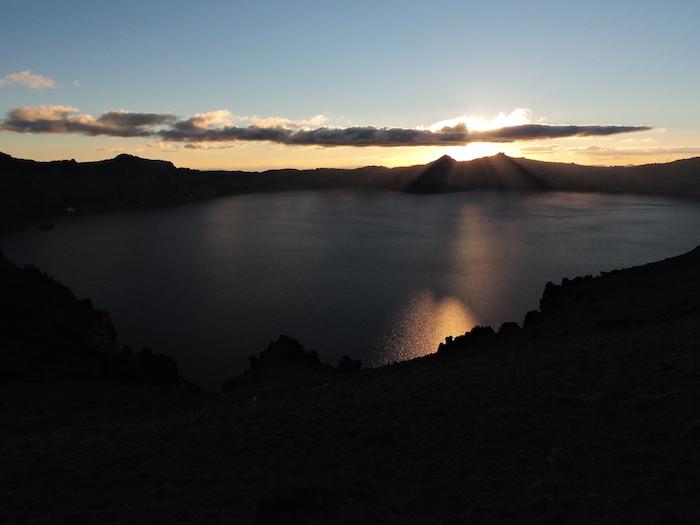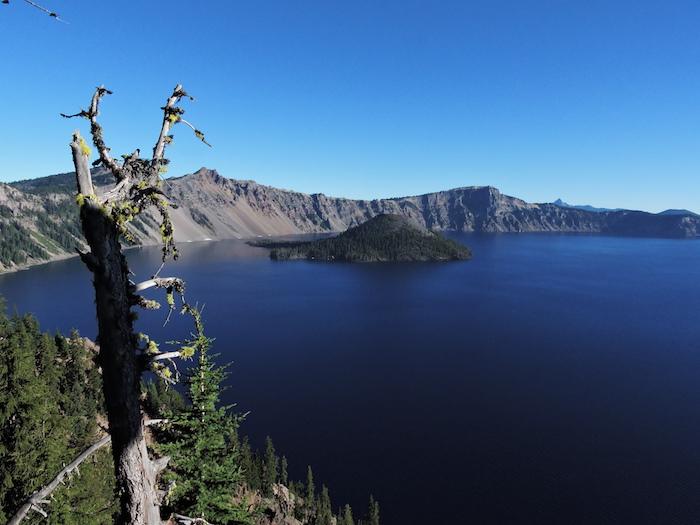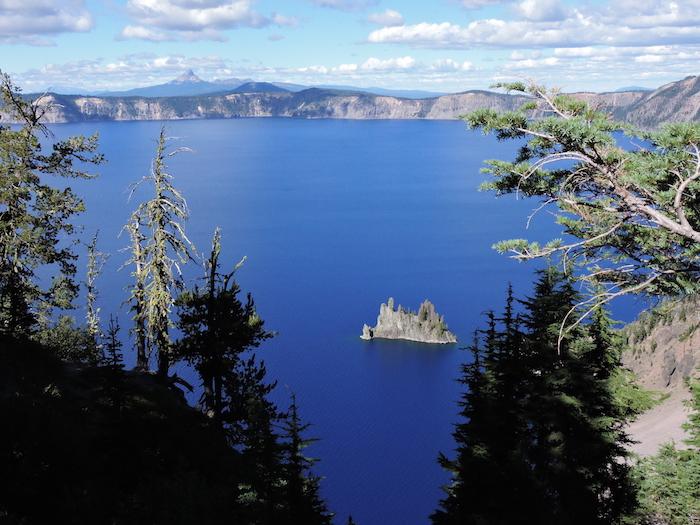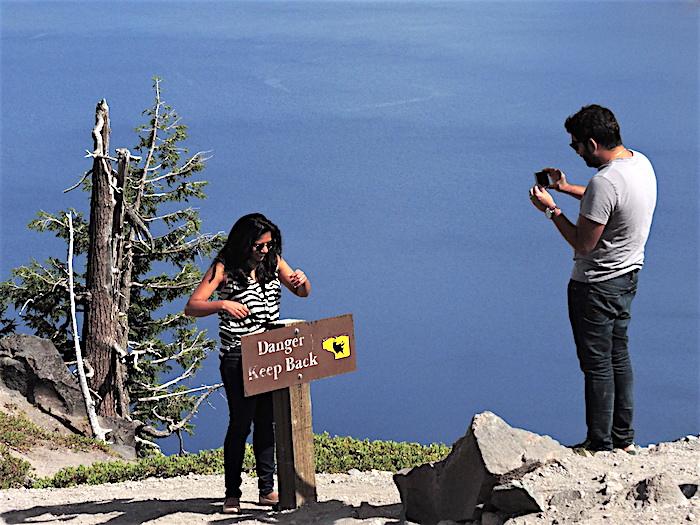
Sundown on Crater Lake/Lee Dalton
Crater Lake sneaks up on you. The mountain holding the lake is just one more of many rather nondescript mounds on the horizon. After driving for what seems like an endless chain of miles through beautiful old growth forest, you finally crest out at a place called Rim Village. When I arrived there before noon on September 1, parking lots at the village had plenty of empty spaces. I left my truck and walked a short distance to the first place I could glimpse the legendary lake.
Great disappointment.
The bowl that holds the lake was full of smoke. So much smoke that it was impossible to see cliffs on the other side, only about five miles distant. You couldn’t even really see the water, and fabled Wizard Island was just a faint outline of silhouetted smudge against gray smoke from some huge fires a few miles southwest in Oregon and northern California. Everything was shades of gray.
I could see looks of dismayed disappointment on other faces all around me. I wandered around a little longer before finally clambering into my truck to return to Camp Mazama a few miles down the road in Mazama Village. It was a good chance to take a nap.
Around 3, I heard some wind in the trees and looked outside. I could actually see a few blue holes in the cloudy sky above, so I scrambled into the truck and headed for the rim again. This time, there was no disappointment.
Rangers there tell us that everyone who reaches the rim and suddenly grasps that first glimpse of the lake has the same reaction. I stopped dead in my tracks – and so did the young couple just in front of me. We stood. Our mouths dropped open and I’m sure all three of us drew sudden gasps. Oh My Goodness!
There was still some smoke, but it didn’t really dampen the surprise that comes the first time you see that deep, deep Blue. That Blue that simply can’t be described – and, as I was soon to learn – is almost impossible to accurately capture in a photo. Even though that first look at the lake was still dampened by smoke, the Blue was almost overwhelming. I might have been even more awed if I’d known at the time that the next days would be free of smoke and the Blue would be even Bluer.
I just walked and looked and looked and walked and started shooting what would eventually turn out be over 400 photos. (Y’gotta love digital cameras!)

Big Blue and Wizard Island/Lee Dalton
Geology and Water
Crater Lake formed inside an ancient volcano called Mount Mazama when a gigantic volcanic belch blew so much molten rock out of the mountain that its upper walls collapsed into the resulting void. What was left was a crater several thousand feet deep. It is a complex geologic drama that has given geologists thousands of questions to answer and visitors thousands of things to see. Things like the pinnacles of ash welded together by escaping hot gases that created chimneys of stone. A short side road takes you to see them.
Thousands of years of rain and snow slowly filled the hole with some of the most pure water found anywhere on our planet. It’s also one of the deepest lakes in North America and among the deepest anywhere in the world.
No water flows into the lake from rivers or streams, and none flows out. It’s that isolation and annual fall of about 45 feet of clean snow that is responsible for the lake’s pure water. Evaporation and seepage just about equal annual precipitation to naturally maintain the lake’s water level.
Now, the National Park Service is working hard to protect that purity. So far, human activity hasn’t had much effect – probably because there isn’t a whole lot of industrial activity in the surrounding countryside. Most of Crater Lake National Park is neighbored by immense stretches of national forest. Beyond that lies agricultural land.
Regulations regarding fishing and swimming in the lake are all intended to protect the water. Its quality is constantly monitored. There is also concern that increasing global temperatures will warm the lake’s water and allow growth of algae and other organisms that would certainly begin to kill the Blue. Decreasing snowfall will certainly limit recharging the lake with new water. I can’t imagine what might be done if our luck runs out and plumes of pollution begin to invade.
Let’s hope that never happens.
There’s a Whole Lot More to Crater Lake
I’m sure the vast majority of visitors to Crater Lake do little more than take some quick looks at the Blue from various overlooks along the 33 miles of Rim Drive before heading on to some other destination. I feel sorry for them, but thankful at the same time. They are leaving the park a little less crowded for those who want to experience and not just look.
Although I was told several times that Crater Lake, like so many other parks, is experiencing record visitation, it only seemed crowded on Sunday and Monday of Labor Day weekend. Parking lots at overlooks were sometimes full, but most trails did not seem crowded.
More than 95 percent of the park is designated wilderness. The park’s brochure lists 16 hiking trails that range from round trips of less than a mile to a dozen. A section of the Pacific Crest Trail runs north and south through the park. For backpackers along the PCT, Mazama Village’s campground, store, eatery, shower, and the park’s post office provide important respite and resupply. As I met some of them and listened to their talk, I became more than just a bit depressed because I wasn’t hiking with them.
But I did manage to put a few good miles under my boots along some of the trails. My favorite jaunt was along a series of trails extending around the west side of the lake rim from Rim Village to Watchman Overlook. Even though it closely parallels the West Rim Drive, much of it is just far enough from the road that one can almost ignore its traffic. It was crowded only in short spurts near parking turnouts. For the most part, I was pretty much alone walking right on the edge of the thousand foot drop to the Blue.
I’d have hiked farther, but an unseasonably COLD cold snap was snapping at me, and I hadn’t worn a warm enough jacket. Besides, I had come down with what felt like a terminal case of bronchitis and was barking like the dogs a few campsites over from where I had set up. I finally gave in and hitched a ride back to my truck at Rim Village with a young Air Force airman who figured he was healthy enough to resist any germs I might have tried to share with him.
Thanks, Airman First Class Tim Ryder, wherever you happen to be today.

Phantom Ship, a volcanic plug inside a caldera/Lee Dalton
Besides miles of hiking trails and plenty of overlooks, another highlight of Crater Lake has to be a boat tour. Space is limited to 37 passengers on each of three boats, so advance reservations are essential. They are available by calling the park’s concessionaire, Xanterra. (The phone number is available on the park’s website.) About half the tickets may be reserved, while the remainder are open to purchase 24 hours before the tour at kiosks located in the Crater Lake Lodge and at the Annie Creek Gift Shop in Mazama Village.
There is a fleet of small shuttle buses disguised as old-fashioned trolley cars in which you may take a ranger-narrated ride around the crater. But it’s awfully expensive at $27 per adult and $17 per child. I passed on that.
I had reserved boat tickets a month or more before leaving home. The hike from the Cleetwood parking lot down to the boat dock is 1.1 miles and 1,100 vertical feet. Not bad, but the trip back up is 11 miles and 11,000 vertical feet. I have to admit that I surrendered to the bronchitis bug that had invaded me and skipped the boat ride.
Now I have one more great reason to visit Crater Lake again.
A Few Grumblings and Happy Rumblings
Part of the adventure of visiting Crater Lake is driving the Rim Drive. Although the West Rim Drive is being rebuilt, the East Rim Drive is, like too many other park roads around the country, not in very good condition. Pavement is rough in spots, and the road simply wasn’t built for heavy traffic and large vehicles. In most places, there is no road shoulder at all, and the drop-off is severe. I noticed frequent white glowing objects on top of oncoming cars’ steering wheels. It took a while to figure out that they were drivers’ white knuckles as they clamped a death grip on the wheel. I found it was essential to stick as close as possible to the white delineator line when driving the uphill side of the road. Thus I was less likely to meet head-on with someone who was driving halfway in my lane in a desperate attempt to stay as far from the cliff edges as possible.
Maybe some of them had a good idea though. They seemed to be driving with their eyes shut. Much less frightening that way ...
I guess I should confess that even the fearless mountain driver that I am occasionally felt a little posterior puckering when I glanced away from the center line toward the downhill edge of the road or met a big RV or other vehicle that was across the yellow line into my lane. When the speed limit sign says 30, it means it!
= = = =
I arrived at Crater Lake on the verge of Labor Day Weekend and just before interpretive offerings were due to end. Things were already starting to thin out as seasonals began heading home for winter. Even so, I was able to enjoy some excellent ranger programs - and one that was the worst I’ve ever seen. But that’s all I will say about that one.
A particularly outstanding evening program was presented by Ranger Brian Ettling. The Good, the Bad, and the Ugly was an unflinching look at global warming. He handled that hot potato with lots of fine humor and carefully documented facts. I noticed that all his slides of graphs and data also contained citations of sources.
After his program, I asked if audiences were normally as supportive as the one he had that night. He said that in most cases they are. When he is confronted, he says he simply gives the person respect and listens to what they have to say. Normally, that respect is returned.
Ettling is a veteran of 20 seasons here and at Everglades. His home is in St. Louis, and he spends some of his off-season writing and speaking on environmental topics.
Another excellent evening program, Denizens of the Dark, was the work of Ranger Kim Smith. She used a fun-filled audience participation game to get things started. It was a quiz game that required audience members to answer questions about the park. Everyone with an answer was rewarded with a Junior Ranger sticker. Most telling of the program’s quality, however, was the fact that even though it was a terribly cold night, no one left early.
= = = =

There are plenty of places to pose for photographs along the rim; just watch your footing/Lee Dalton
Mazama Campground is managed by Xanterra. Reservations are a very good idea and are made by calling Xanterra directly. They have an interesting method of assigning campsites that I thought was really good. Sites are marked by colored posts that designate the size of outfit they can handle. Blue might be tents-only, while a yellow post indicates it will hold something really big. When you arrive and show your reservation, you are told to go looking for posts with a particular color beside an empty site. That way, you have a choice and can’t blame anyone else if you pick one too close to the dumpsters or too far from the potty.
It also allows some flexibility. When I decided to extend my stay by a couple of nights, I was able to remain in the same site. In other places, I’d have had to move if the site was specifically reserved for someone else.
Hats off to the unknown somebody who came up with this idea!
= = = =
The first couple of days I was at Mazama, the restroom I used was in awfully crummy condition. Its floor hadn’t seen a mop for a long time, and pieces of litter on the floor hadn’t moved, although it did appear someone was cleaning sinks and toilets and restocking TP. I finally commented about that at the campground registration kiosk. Just a few minutes later, a man pulled up at the restroom. He had that look about him. You know, the bearing and appearance of a supervisor. When I headed to the restroom again, it was spotless. A little while after that, I saw the supervisor and went to talk with him. He thanked me for letting them know of the problem and said it was due to a young substitute for the regular cleaning guy. “But we had a little counseling session and it won’t happen again.”
= = = =
Crater Lake’s NPS visitor centers and other facilities are old, but classics of park architecture. The Steel Visitor Center at park headquarters is converted from an early 1900s-era employee housing building. A tiny room housing the information center and bookstore was so jammed one time I was there that I had to wait several minutes just to get through the door. Once inside, it was almost impossible to move without stepping on someone else. The center at Rim Village is an old stone house that looks like it once was housing for someone. But y’know what? They should never be changed! Old and inadequate as they may be, they are as much of the park’s texture as the Blue Water of the lake. A new visitor center is certainly needed, but it should be down by development already located at Annie Creek in Mazama Village.
Crater Lake Lodge is another gem. There are ranger-led tours of the lodge, but those tours had ended the day before I arrived.
= = = =
It was at Mazama Campground that I noticed again how many more people are traveling these days with herds of dogs. One camp had at least five tied to trees. All barking. You had to watch where you stepped. I cleaned up five piles in my site alone. I don’t mind dogs if they have civilized owners, but I just cannot comprehend traveling in a car filled with flying dog fur and hound slobber. But to each their own. If they don’t impose their menageries on the rest of us.
= = = =
It’s a rainy Sunday back in Utah as I write this. There is no doubt that I really do need to return to Crater Lake. This time with another boat tour ticket and without bronchitis germs. There’s still a lot of park left for me to discover.
Isn’t it grand to have places like Crater Lake to look forward to?



Comments
For your White Knuckle Index, nothing beats the road descending into Palo Duro Canyon in the Texas Panhandle. Yeah, I know it's a state park, but after you've driven it a few times, Trail Ridge and the others will seem ho-hum. My best experiences have involved me pulling a 16-foot horse trailer, going up out of the park with the dropoff on my right, coming radiator-to-radiator with Mr. Magoo in his RV bigger than my living room and taking his half of the road out of the middle.
Lee - I like that in your park reports you mention park staff by name when complimenting them. These are folks with a low enough paying job that public acknowledgement makes it more worthwile.
Compare: https://en.wikipedia.org/wiki/Lake_Baikal and http://lakebaikal.org/
Also: craterlakeinstitute.org
One interesting historic story on Crater Lake's Water Purity Issue is the fact that since the early days of old Crater Lake Lodge, (1915 thru 1989) a large, poorly functioning septic system was placed very close to the Caldera's edge near the beginning of the GARFIELD PEAK TRAIL.
My first visits to Crater Lake are indelible in my memory because the 1960s visitor was greeted by obnoxious odors overwhelming hikers along the beginning of the Garfield Peak Trail as the summer's temperatures warmed. This all played into a serious water crisis when in 1975, the park was closed by the Center for Disease Control for three weeks mid-summer since many employees and visitors were becoming ill. The park water source at that time was a surficial spring within the horseshoe curve of the road leading to the rim.
Turns out that Denver Service Center planners had decided to lay the rim sewer line above this spring increasing the probability of water contamination given sewer line overflows and leakage. The park had no preventative protocols for monitoring the purity of the park's drinking water. Once this fiasco was suffered, Anna Spring near Mazama Campground became the new Crater Lake Park water source.
Volunteer Limnologist, Dr. Doug Larson, had been monitoring the Lake Clarity and detected a measurable decrease which he interpreted to be possible sewage contamination.
The "rest of the story" may be read at Crater Lake Institute Oral Histories:
http://www.craterlakeinstitute.com/oral-histories/
Thank you, m13, for the link to Crater Lake Institute's website. It looks like a real treasure trove.
Do go back and take that boat ride. In addition to the ride, you also have the chance to get off and hike around Wizard Island.
Your white knuckle description of the rim road sort of boggled me. I don't remember it being all that bad, especially compared to Trail Ridge or the Sunrise Road at Mt. Rainier or Wheeler Peak (which scared the begeebers out of me last summer [g]).
All I can say is that is the only body of water that took my breath away on a clear day.That water is BLUE.
We found the food at the lodge to be some of the best served at any National Park.
As we drove around the rim we came upon an accident that had just occurred, it happened to be seasonal employees.
The park ranger said they were the worst offenders. Young and without fear.
The road that was my white knuckle adventure was coming out of Valley of the God's near Monument Valley it's steep with cutbacks on a grave road almost single lane to the plateau of Utah going toward Canyonland southern unit.I've been on all including Mt Washington and this was by far the one that had me sweating .It was featured on the cover of Rand McNally some years ago.
Perhaps Lee you have been on that one being from Utah.
Another great piece, Lee.
I'm with Kurt--Trail Ridge Rd at RMNP; never want to drive that one again.
Hiking Wizard Island is indeed a lot of fun. My girlfriend (now wife) actually got in the lake for a (very short) swim. Pretty brave.
It really wasn't so much the road that causes white knuckles. It's those folks who take their half out of the middle. That and humongous RVs on a road never intended for them.
It's not the wildest I've ever driven by a long shot, but it's one that needs a driver's full attention.